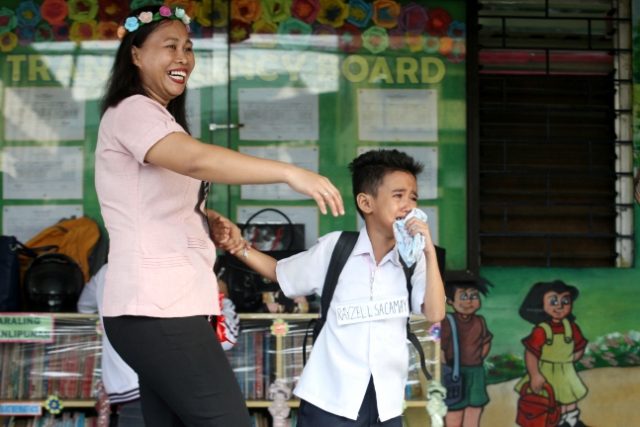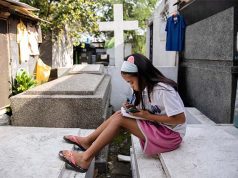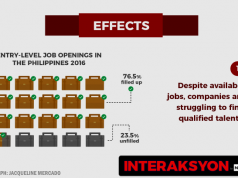
MANILA – The NGO Philippine Business for Education (PBEd) points out that the country’s would-be teachers have been performing poorly in the Board Licensure Examination for Professional Teachers (BLEPT) since September 2009, when it first kept tabs of the examination results.
Due to this “dismal” situation, PBEd is urging the Professional Regulation Commission (PRC) to make the BLEPT public so that it can be scrutinized by experts, and so that the test’s relevance to the educational preparation of the examinees can be better discerned.
Scholars argue that vapid questions such as “What does TOC stand for?” (The answer: “Table of Contents”) even appear on the BLEPT.
PBEd executive director Love Basillote and research manager Dylan Dellosa presented their findings at a press conference Monday, where they pointed out that not much had changed in BLEPT performance levels since the last few years.
From September 2009 to March 2017, the average national passing rate had been less than exemplary for examinees of both elementary and secondary education.
For elementary education, the national passing rates were:
2009 21% (September)
2010 18%
2011 21%
2012 48%
2013 31%
2014 34%
2015 30%
2016 29%
2017 11%
This year, the teacher education institutions [TEIs] and the Professional Regulation Commission improved their “alignment,” according to Basillote, which made the BLEPT questions more relevant to what the schools were teaching.
For secondary education, the national passing rates were:
2009 29% (September)
2010 26% in 2010
2011 30% in 2011
2012 37% in 2012
2013 40% in 2013
2014 33% in 2014
2015 38% in 2015
2016 35% in 2016
2017 26% (March)
“There is no proxy for quality more objective when it comes to teacher education programs, apart from the licensure exam,” Basillote explained.
She added that, by improving the quality of the TEIs, the quality of teacher education could be improved, too.
To underscore the dire circumstances further, PBEd reported that in the March 2017 BLEPT, 72 percent of over 100,000 examinees were retakers.
In fact, from September 2009 to March 2017, close to half of the TEIs offering elementary education had below national passing rates (497 out of 1,024 TEIs), and a little over half of the TEIs offering secondary education had below national passing rates (637 out of 1,258 TEIs).
In the same period, poorly-performing TEIs offering elementary education in nine regions outnumbered good ones:
Ilocos Region (33 out of 58 TEIs),
Cagayan Valley (27 out of 43 TEIs),
Mimaropa (15 out of 28 TEIs),
Bicol Region (43 out of 75 TEIs),
Eastern Visayas (29 out of 54 TEIs),
Zamboanga Peninsula (44 out of 58 TEIs),
Soccsksargen (22 out of 39 TEIs),
Caraga (30 out of 39 TEIs), and
ARMM (32 out of 36 TEIs).
There were more poorly-performing TEIs offering secondary education in 10 regions than good ones:
Ilocos Region (42 out of 69 TEIs),
Cagayan Valley (25 out of 49 TEIs),
Mimaropa (19 out of 34 TEIs),
Bicol Region (56 out of 91 TEIs),
Eastern Visayas (40 out of 56 TEIs),
Zamboanga Peninsula (49 out of 54 TEIs),
Northern Mindanao (29 out of 54 TEIs),
Soccsksargen (27 out of 41 TEIs),
Caraga (29 out of 37 TEIs), and
ARMM (39 out of 40 TEIs).
“I suspect there is a disconnect between the exam and what is being taught,” said Dellosa. “But since the exam is cloaked in mystery, we have no way of knowing.”
“We want to be able to test the test,” he said. “Nobody really knows what happens in test development.”
He added, “In terms of coverage, we don’t really know whether (the tests for) elementary and secondary education are significantly different from each other because they should be.”
PRC refused to release the questionnaire for every BLEPT, so PBEd was considering using the government’s Freedom of Information website to obtain them, and hoping they are not covered by the exceptions under President Rodrigo Duterte’s Executive Order No. 2.
“There are also questions about the quality of the test in the first place. Whenever we have a discussion forum, educators always ask: ‘Is the test itself of high quality?’ Because in many countries, they certify teachers differently. It’s not just purely on one standardized exam.
“And so, we’re also calling on the new PRC chair … to release the exam after each test instance, so that it can be scrutinized by experts as to whether it’s really a good screening mechanism or not,” Basillote said.
Aside from that, she recommended that a three-strike rule be applied for those taking the BLEPT. Perhaps, after failing on the third take, an examinee could take a review course.
Programs that had been performing poorly consistently should be closed, as well. For PBEd, being a bad performer meant that less than 20 percent of the TEI’s students passed the BLEPT.
“I think it’s really a disservice to the (graduates) and their families that they get access to a school, but don’t get certified or they fail eventually in the last step before they can actually teach,” Basillote said.
She noted that a few TEIs that had been performing poorly and were reported by PBEd in previous years had already closed their education programs.
Meanwhile, Dellosa observed that continuing education for teachers is not compulsory; rather, it’s up to their employer to provide.
“Teaching has come to have this reputation of just being a back-up plan,” he pointed out.
PBEd’s aim is to change this image by turning teaching into a viable and rewarding profession. This meant salaries and incentives must be improved, Dellosa said.
He also suggested that TEIs make use of a more stringent admissions process.
“Right now, anyone can teach,” he said. Perhaps it could be that only the top 20 percent of the graduating high school batch would be accepted into TEIs. In other countries, it was even the Top 10 percent.





